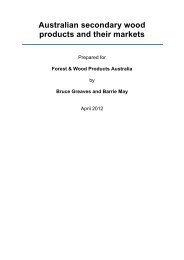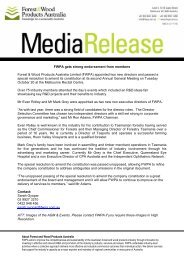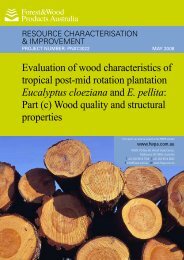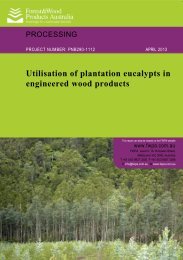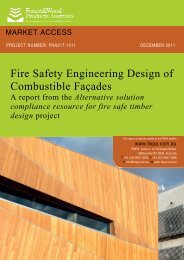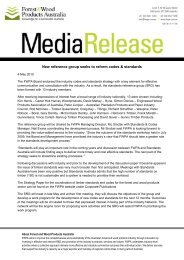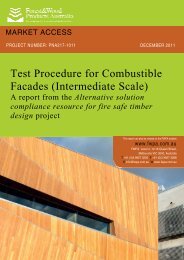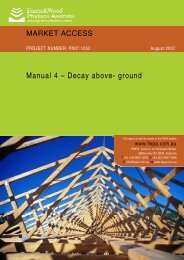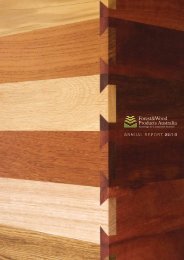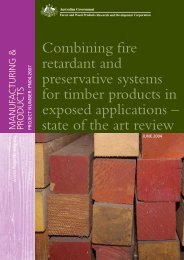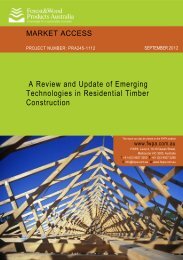guide to the specification, installation and use of preservative treated ...
guide to the specification, installation and use of preservative treated ...
guide to the specification, installation and use of preservative treated ...
You also want an ePaper? Increase the reach of your titles
YUMPU automatically turns print PDFs into web optimized ePapers that Google loves.
GUIDE TO THE SPECIFICATION, INSTALLATION<br />
AND USE OF PRESERVATIVE TREATED<br />
ENGINEERED WOOD PRODUCTS<br />
The following measures may be employed <strong>to</strong> protect <strong>the</strong> fastener <strong>and</strong> <strong>the</strong> surrounding wood structure:<br />
Shield <strong>the</strong> connection from <strong>the</strong> wea<strong>the</strong>r <strong>and</strong> moisture.<br />
Use non-corrosive or protected metals (galvanised or protective coating)<br />
Prevent moisture traps by countersinking <strong>and</strong> plugging fasteners<br />
Don’t <strong>use</strong> dissimilar metals in contact with each o<strong>the</strong>r (be aware <strong>of</strong> metals <strong>use</strong>d in wood<br />
<strong>preservative</strong> treatment)<br />
Grease, coat or sheath fasteners <strong>to</strong> isolate from wood surface. This is particularly important<br />
where EWP components have been <strong>treated</strong> with water-borne copper treatments such as<br />
CCA, ACQ <strong>and</strong> copper azole. ACQ <strong>and</strong> Copper azole have been found <strong>to</strong> have around twice<br />
<strong>the</strong> corrosion rate <strong>of</strong> CCA.<br />
Moisture affects on stability<br />
EWPs, like all wood products, are hygroscopic, which means <strong>the</strong>y have an affinity for water. EWPs<br />
will readily take up <strong>and</strong> release moisture in response <strong>to</strong> changes in <strong>the</strong> local environment. Most water<br />
is removed from <strong>the</strong> wood structure <strong>of</strong> EWPs during <strong>the</strong> manufacture process. Effective glue bonding<br />
requires lowered moisture content in <strong>the</strong> wood components. For example at <strong>the</strong> time <strong>of</strong> manufacture<br />
OSB has a moisture content <strong>of</strong> 2-3%, plywood about 6-8%, I-beams about 8-12%, <strong>and</strong> Glulam about<br />
10-14%. Post manufacture <strong>and</strong> during service EWPs may be exposed <strong>to</strong> environmental conditions<br />
that ca<strong>use</strong> changes in <strong>the</strong>ir moisture content, <strong>and</strong><br />
<strong>the</strong>refore <strong>the</strong>ir dimensions.<br />
EWPs will shrink <strong>and</strong> swell in proportion <strong>to</strong> changes<br />
in <strong>the</strong>ir moisture content between 0 <strong>and</strong> 30% fibre<br />
saturation point. The most significant moisture<br />
movement will occur across <strong>the</strong> grain (tangential<br />
<strong>and</strong> radial directions within a log). Longitudinal<br />
movement (in <strong>the</strong> grain direction) may be a fac<strong>to</strong>r<br />
depending upon <strong>the</strong> particular EWP <strong>and</strong> <strong>the</strong> type <strong>of</strong><br />
structure. EWPs will generally be more stable than<br />
solid kiln dried timber beca<strong>use</strong> <strong>the</strong> process <strong>of</strong> gluing<br />
<strong>to</strong>ge<strong>the</strong>r multiple wood components tends <strong>to</strong><br />
r<strong>and</strong>omise <strong>and</strong> balance moisture responses.<br />
Warping, bow <strong>and</strong> spring may still result in response<br />
<strong>to</strong> differential moisture content.<br />
Dimensional change:<br />
ΔD = Di S (MCi – MCf)/ FSP<br />
where<br />
ΔD = change in dimension<br />
Di = initial dimension<br />
S = shrinkage coefficient<br />
(Plywood = 3.5, LVL = 6.0% radial,<br />
Particleboard = 1.7% typical)<br />
MCi = initial moisture content<br />
MCf = final moisture content<br />
FSP = fibre saturation point<br />
(approx. 28%)<br />
Where <strong>the</strong> possibility <strong>of</strong> wetting exists, design <strong>and</strong><br />
detailing should allow for dimensional instability. For example, structural plywood or OSB sheathing<br />
panels should be installed with a minimum 2 mm gap around panel edges <strong>to</strong> prevent warping.<br />
Dimensional changes <strong>to</strong> EWP in response <strong>to</strong> changes <strong>to</strong> moisture content can be estimated from<br />
known shrinkage coefficients for <strong>the</strong> product <strong>and</strong> direction within <strong>the</strong> product from <strong>the</strong> equation shown<br />
above. Values <strong>of</strong> shrinkage coefficient may be obtained from <strong>the</strong> product manufacturer.<br />
EWPs such as OSB <strong>and</strong> particleboard which are densified in <strong>the</strong> manufacture process may exhibit<br />
irreversible swelling due <strong>to</strong> cyclical moisture effects.<br />
Glue durability<br />
Durability <strong>of</strong> <strong>the</strong> adhesives <strong>use</strong>d <strong>to</strong> manufacture EWPs is integral <strong>to</strong> <strong>the</strong> product performance. The<br />
adhesives <strong>use</strong>d need permanence <strong>and</strong> non-creep characteristics <strong>to</strong> ensure performance under long<br />
term exposure. A wide variety <strong>of</strong> adhesives are available for <strong>the</strong> manufacture <strong>of</strong> EWPs.<br />
Manufacturers select adhesives appropriate for <strong>the</strong> intended applications <strong>of</strong> <strong>the</strong>ir products. Type I<br />
adhesives include resorcinol, phenol-resorcinol <strong>and</strong> poly-phenolic adhesives <strong>and</strong> are generally viewed<br />
as suitable for long-term, exposed applications. Type II adhesives include melamine-urea<br />
formaldehyde (MUF) <strong>and</strong> are generally viewed as suitable for long-term interior/protected<br />
applications. At <strong>the</strong> time <strong>of</strong> publication polyurethane (isocyanate) adhesive has not formally been<br />
classified, but is generally accepted as exceeding <strong>the</strong> requirement for Type II. For example structural<br />
LVL <strong>and</strong> plywood manufactured <strong>to</strong> AS/NZS4357 <strong>and</strong> AS/NZS2269 respectively are required <strong>to</strong> <strong>use</strong><br />
Type I adhesives (Type A bond - permanent). O<strong>the</strong>r EWPs may <strong>use</strong> Type I or II or o<strong>the</strong>r adhesives<br />
depending upon <strong>the</strong> intended application. Type I adhesives are generally suitable for applications<br />
where <strong>the</strong>re is full exposure <strong>to</strong> wea<strong>the</strong>r <strong>and</strong> where <strong>the</strong>re may be prolonged exposure <strong>to</strong> high<br />
Page | 15



